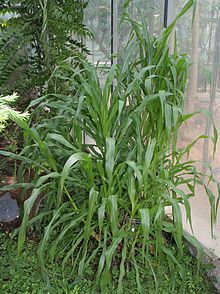bio.wikisort.org - Plant
Zea diploperennis, the diploperennial teosinte,[2] is a species of grass (family: Poaceae) in the genus Zea and a teosinte (wild relative of maize or corn). It is perennial.
| Zea diploperennis | |
|---|---|
 | |
| Zea diploperennis, Conservatoire botanique national de Brest, France, June 2007 | |
Conservation status | |
| Scientific classification | |
| Kingdom: | Plantae |
| Clade: | Tracheophytes |
| Clade: | Angiosperms |
| Clade: | Monocots |
| Clade: | Commelinids |
| Order: | Poales |
| Family: | Poaceae |
| Subfamily: | Panicoideae |
| Genus: | Zea |
| Species: | Z. diploperennis |
| Binomial name | |
| Zea diploperennis H.H.Iltis Doebley & R.Guzman & Pazy B., 1979 | |
Conservation
Virtually all populations of this teosinte are either threatened or endangered: Z. diploperennis exists in an area of only a few square miles. The Mexican and Nicaraguan governments have taken action in recent years to protect wild teosinte populations, using both in situ and ex situ conservation methods. Currently, a large amount of scientific interest exists in conferring beneficial teosinte traits, such as insect resistance, perennialism, and flood tolerance, to cultivated maize lines, although this is very difficult due to linked deleterious teosinte traits. Researchers are studying Z. diploperennis as its genes provide resistance against Striga, which can decrease grain yield.[3] [4]
References
- Aragón Cuevas, F., Contreras, A., de la Cruz Larios, L., González Ledesma, M., Ruíz Corral, J.A., Menjívar, J. & Sánchez, J.J. 2019. Zea diploperennis. The IUCN Red List of Threatened Species 2019: e.T77726057A77726102. https://dx.doi.org/10.2305/IUCN.UK.2019-2.RLTS.T77726057A77726102.en. Accessed on 28 October 2022.
- USDA, NRCS (n.d.). "Zea diploperennis". The PLANTS Database (plants.usda.gov). Greensboro, North Carolina: National Plant Data Team. Retrieved 9 August 2015.
-
- Jamil, Muhammad; Kountche, Boubacar A; Al-Babili, Salim (2021-02-05). "Current progress in Striga management". Plant Physiology. American Society of Plant Biologists (OUP). 185 (4): 1339–1352. doi:10.1093/plphys/kiab040. ISSN 0032-0889. S2CID 232762845.
- Yacoubou, Abdoul‐Madjidou; Zoumarou Wallis, Nouhoun; Menkir, Abebe; Zinsou, Valerien A.; Onzo, Alexis; Garcia‐Oliveira, Ana Luísa; Meseka, Silvestro; Wende, Mengesha; Gedil, Melaku; Agre, Paterne (2021). "Breeding maize (Zea mays) for Striga resistance: Past, current and prospects in sub‐saharan africa". Plant Breeding. Wiley. 140 (2): 195–210. doi:10.1111/pbr.12896. ISSN 0179-9541. PMC 8248382. PMID 34239217. S2CID 233774262.
- Akaogu, Ijeoma C.; Badu‐Apraku, Baffour; Tongoona, Pangirayi; Ceballos, Hernan; Gracen, Vernon; Offei, S. K.; Dzidzienyo, Daniel (2019-04-16). "Inheritance of Striga hermonthica adaptive traits in an early‐maturing white maize inbred line containing resistance genes from Zea diploperennis". Plant Breeding. Wiley. 138 (5): 546–552. doi:10.1111/pbr.12707. ISSN 0179-9541. S2CID 145851144.
-
- Mammadov, Jafar; Buyyarapu, Ramesh; Guttikonda, Satish K.; Parliament, Kelly; Abdurakhmonov, Ibrokhim Y.; Kumpatla, Siva P. (2018-06-28). "Wild Relatives of Maize, Rice, Cotton, and Soybean: Treasure Troves for Tolerance to Biotic and Abiotic Stresses". Frontiers in Plant Science. Frontiers. 9. doi:10.3389/fpls.2018.00886. ISSN 1664-462X. PMC 6032925. PMID 30002665. S2CID 49480613.
- Yallou, C. G.; Menkir, A.; Adetimirin, V. O.; Kling, J. G. (2009). "Combining ability of maize inbred lines containing genes from Zea diploperennis for resistance to Striga hermonthica (Del.) Benth". Plant Breeding. Blackwell. 128 (2): 143–148. doi:10.1111/j.1439-0523.2008.01583.x. ISSN 0179-9541. S2CID 84771595.
External links
На других языках
- [en] Zea diploperennis
[es] Zea diploperennis
El teosinte diploperenne (Zea diploperennis)[1] es una especie de planta, pariente silvestre del maíz. Se clasifica dentro del género Zea perteneciente a la familia de las gramíneas junto con una gran variedad de cultivos agrícolas como el trigo, arroz, avena, sorgo, cebada y caña de azúcar. Además de ser nativo es endémico de México. Representa una fuente de genes para el mejoramiento del maíz. Su descubrimiento contribuyó a la creación de la Reserva de la biosfera Sierra de Manantlán.Другой контент может иметь иную лицензию. Перед использованием материалов сайта WikiSort.org внимательно изучите правила лицензирования конкретных элементов наполнения сайта.
WikiSort.org - проект по пересортировке и дополнению контента Википедии
